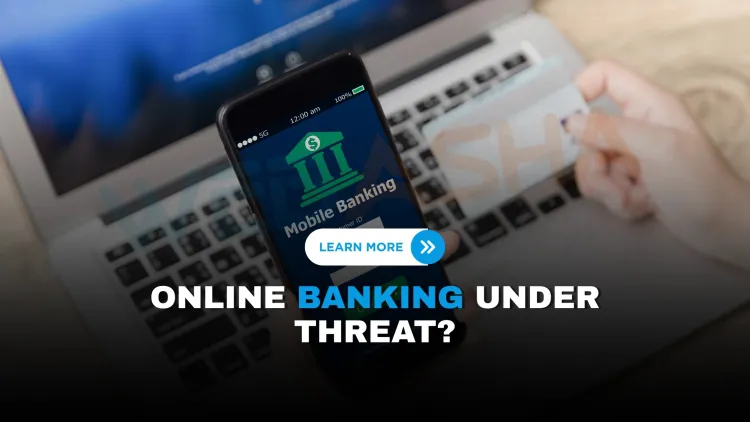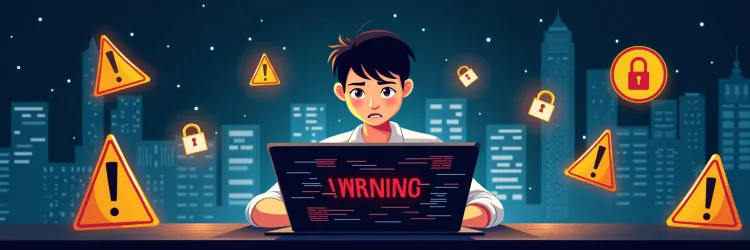10 Warning Signs Your Online Bank Account Is Under Cyber Attack | How to Detect and Protect Your Money
Cyber attacks on online bank accounts have increased significantly in recent years, with hackers using methods like phishing, malware, and credential stuffing to gain unauthorized access. In this guide, we break down 10 clear signs your online banking account may be compromised — from unexpected login alerts and unfamiliar devices to unauthorized transactions and suspicious password reset requests. The blog also shares actionable steps you can take to secure your online financial accounts, including enabling two-factor authentication, monitoring transaction history, and avoiding phishing scams.

Table of Contents
- Why Online Bank Accounts Are Prime Targets
- 10 Signs Your Online Bank Account Is Under Cyber Attack
- How to Protect Your Online Bank Account
- Conclusion
- Frequently Asked Questions (FAQs)
Online banking has made life more convenient, but it has also opened the door to sophisticated cyber attacks. Hackers now use malware, phishing, and account takeover methods to target personal and business bank accounts. Being able to spot early warning signs can help you prevent financial loss and identity theft.
In this blog, we’ll break down 10 clear signs your online bank account might be under cyber attack, followed by practical tips to secure your financial information.
Why Online Bank Accounts Are Prime Targets
Cybercriminals target online bank accounts because of the direct financial gain and valuable personal data linked to them. From login credentials to sensitive business transactions, a compromised account offers attackers both money and leverage.
According to recent reports, over 70% of banking frauds in 2025 involve account takeover using phishing, malware, or credential stuffing attacks.

10 Signs Your Online Bank Account Is Under Cyber Attack
1. Unexpected Login Alerts from Unknown Locations
If your bank notifies you about login attempts or successful logins from unfamiliar cities or devices, treat it as a red flag. Even if the attempt was unsuccessful, it means your credentials might have been leaked.
Tip: Enable two-factor authentication (2FA) and immediately change your password.
2. Unauthorized Transactions or Withdrawals
Sudden charges, withdrawals, or money transfers that you didn’t initiate are clear signs of account compromise. These could be small test transactions or large amounts siphoned off quickly.
Tip: Review your transaction history daily and report suspicious activity to your bank immediately.
3. Your Bank Account Gets Locked Out or Suspended
Frequent failed login attempts by attackers may trigger security measures that lock your account. If this happens unexpectedly, it could mean someone is trying to brute-force access.
Tip: Reset your password using a secure device and check for phishing emails related to your account.
4. Strange Devices or Browsers in Your Account Login History
Most banking apps allow you to review devices and sessions. Unknown smartphones, laptops, or browsers showing up indicate unauthorized access.
Tip: Log out from all devices and reset your login details.
5. Receiving Password Reset Requests You Didn’t Initiate
Attackers often try password reset methods. If you get password reset emails, SMS codes, or notifications without asking for them, someone might be trying to take over your account.
Tip: Never click on suspicious password reset links. Always go directly to your bank’s official website or app.
6. Changes in Account Details You Didn’t Make
If your email address, phone number, linked cards, or other personal information suddenly changes, it’s possible an attacker has gained control and is locking you out.
Tip: Immediately contact your bank’s support line if you notice such changes.
7. Receiving Unfamiliar Security Notifications
Some banks send security alerts regarding new device logins, IP changes, or suspicious activities. Ignoring them can leave your account exposed.
Tip: Act on these alerts quickly. If unsure, contact your bank directly rather than using links in emails or SMS.
8. Slow or Laggy Banking App Performance
If your banking app is suddenly slower or behaving oddly, malware might be intercepting data or attackers could be using man-in-the-middle (MITM) attacks.
Tip: Clear cache, update apps, and run antivirus or malware scans on your device.
9. Emails from Your Bank That Seem Suspicious
Phishing emails that appear to come from your bank, asking you to verify your account or provide personal information, are a common attack vector.
Tip: Verify sender addresses carefully and never share sensitive data through email.
10. Receiving OTPs or Verification Codes You Didn’t Request
Attackers using credential stuffing techniques might trigger OTP (One-Time Password) requests. If you receive these unexpectedly, your login information may already be compromised.
Tip: Change your password immediately and enable app-based 2FA instead of SMS OTPs where possible.
How to Protect Your Online Bank Account
-
Use Strong, Unique Passwords: Avoid using the same password across multiple accounts.
-
Enable Two-Factor Authentication (2FA): Prefer app-based or hardware token 2FA over SMS.
-
Monitor Transactions Regularly: Don’t rely solely on your bank to catch fraud. Stay alert.
-
Keep Your Devices Secure: Use up-to-date antivirus software and avoid public Wi-Fi for banking.
-
Beware of Phishing Scams: Verify the source of emails or messages that ask for sensitive information.
Conclusion
Your online bank account is one of your most valuable digital assets. Understanding these 10 signs of a cyber attack can save you from serious financial damage.
If you ever suspect unauthorized activity, contact your bank’s fraud department immediately, secure your devices, and update your credentials. Prevention is always more effective than dealing with the aftermath of an attack.
FAQs
What are the first signs that my bank account is being hacked?
Unexpected login alerts, unauthorized transactions, or password reset notifications are common early signs.
How do hackers gain access to online bank accounts?
They often use phishing emails, malware infections, credential stuffing, or exploiting weak passwords.
Can my online bank account get hacked if I have two-factor authentication?
While 2FA reduces risk, sophisticated hackers can still bypass it using SIM swapping or phishing techniques.
What should I do if I see unfamiliar transactions in my bank account?
Contact your bank immediately, freeze the account, and review all recent activity.
How often should I check my online banking account for suspicious activity?
Ideally, review it daily or at least several times per week.
Can malware steal my online banking login details?
Yes, banking malware like keyloggers or trojans can capture login credentials.
How do I secure my bank account from hackers?
Use strong passwords, enable 2FA, avoid public Wi-Fi, and keep software updated.
Are bank phishing emails easy to spot?
Not always. Modern phishing emails often mimic real bank communications, so always check sender details carefully.
Why am I receiving OTP codes without requesting them?
Someone may be trying to access your account using your password. Change your password immediately.
What is account takeover in banking?
When a hacker gains full access to a bank account and can perform unauthorized transactions.
How do I know if my banking app is compromised?
Unusual lag, frequent crashes, or unknown devices connected to your account are signs.
What is credential stuffing in bank attacks?
Using stolen usernames and passwords from other breaches to access bank accounts.
Can public Wi-Fi put my bank account at risk?
Yes, attackers can intercept your data through unsecured public networks.
What role does two-factor authentication play in banking security?
It adds an extra layer of protection beyond just a password.
How do I reset my bank account password securely?
Always use official bank apps or websites; avoid using links from emails or SMS.
Can changing my password stop a hacker already in my account?
It can help, but you should also check for devices logged in and revoke access.
What is SIM swapping in banking fraud?
Attackers transfer your phone number to their device to intercept OTPs.
How do I monitor login activity on my bank account?
Check the security or login history section in your banking app or website.
Are small unauthorized transactions dangerous?
Yes, attackers often test small amounts before making larger withdrawals.
Can antivirus software protect my online banking account?
It helps detect banking malware but doesn’t replace good security practices.
How do I spot a fake bank website?
Check for HTTPS, verify the URL, and look for spelling or layout inconsistencies.
Why do hackers target online banking apps?
They offer direct access to funds and personal information.
How often should I update my online banking password?
At least every 3–6 months, and never reuse passwords from other sites.
What is the safest way to access my bank account online?
Use official apps over a secure Wi-Fi connection and enable biometric authentication if available.
Can banks detect cyber attacks on my account?
Yes, but some attacks are subtle. Always stay proactive by monitoring your account.
What is session hijacking in online banking?
When attackers steal a user’s session cookie to access their account without login credentials.
How can I recover a hacked online bank account?
Contact your bank immediately, change all credentials, and monitor for further fraud.
What are the legal steps if my bank account is hacked?
File a police report and follow up with your bank’s fraud department.
How do I identify malware that targets banking information?
Run a full device scan using reputable antivirus and monitor unusual device behavior.
Should I close my bank account after a cyber attack?
Not always necessary, but changing account numbers and credentials is recommended.
Can hackers access my bank account through social media?
Indirectly, yes. Information from social profiles can aid phishing or credential theft.














![Top 10 Ethical Hackers in the World [2025]](https://www.webasha.com/blog/uploads/images/202408/image_100x75_66c2f983c207b.webp)








